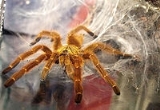
Pterinochilus murinus
Encyclopedia
The baboon spider Pterinochilus murinus, an old-world tarantula
, was first described in 1897 by Reginald Innes Pocock
. This species is found on the Africa
n continent, in Angola
, as well as central, eastern, and southern Africa.
Among those who keep tarantulas as pets Pterinochilus murinus is known as "OBT," which means "Orange Baboon Tarantula" or "Orange Bitey Thing," and also as the "Pterror," a pun on its Latin genus classification: Pterinochilus. These nicknames reference a particular orange color form that is prized in the hobby for its beauty and confrontational personality. It is also known as the Mombasa golden starburst tarantula.
This species is incredibly defensive and should not be held. The bite of this species, while not serious, is extremely painful. Moreover, the species is more than willing to inflict such a bite before presenting the typical threat display. Caution when dealing with this species is advised.
There are currently 4 known colour variants of Pterinochilus murinus:
TCF - Typical Colour Form,
UMV - Usambara Mountain Variant,
RCF - Red Colour Form,
DCF - Dark Colour Form.
These colour variants are found in different geographical locations, and the colouration is thought to be related to the type of soil present where each variant lives.
Tarantula
Tarantulas comprise a group of often hairy and often very large arachnids belonging to the family Theraphosidae, of which approximately 900 species have been identified. Some members of the same Suborder may also be called "tarantulas" in the common parlance. This article will restrict itself to...
, was first described in 1897 by Reginald Innes Pocock
Reginald Innes Pocock
Reginald Innes Pocock F.R.S. was a British zoologist.Pocock was born in Clifton, Bristol, the fourth son of Rev. Nicholas Pocock and Edith Prichard. He began showing interest in natural history at St. Edward's School, Oxford. He received tutoring in zoology from Sir Edward Poulton, and was allowed...
. This species is found on the Africa
Africa
Africa is the world's second largest and second most populous continent, after Asia. At about 30.2 million km² including adjacent islands, it covers 6% of the Earth's total surface area and 20.4% of the total land area...
n continent, in Angola
Angola
Angola, officially the Republic of Angola , is a country in south-central Africa bordered by Namibia on the south, the Democratic Republic of the Congo on the north, and Zambia on the east; its west coast is on the Atlantic Ocean with Luanda as its capital city...
, as well as central, eastern, and southern Africa.
Among those who keep tarantulas as pets Pterinochilus murinus is known as "OBT," which means "Orange Baboon Tarantula" or "Orange Bitey Thing," and also as the "Pterror," a pun on its Latin genus classification: Pterinochilus. These nicknames reference a particular orange color form that is prized in the hobby for its beauty and confrontational personality. It is also known as the Mombasa golden starburst tarantula.
This species is incredibly defensive and should not be held. The bite of this species, while not serious, is extremely painful. Moreover, the species is more than willing to inflict such a bite before presenting the typical threat display. Caution when dealing with this species is advised.
Description
Female P. murinus can grow to 4–6 inches in size (measured from the tip of the front left leg, to the rear right leg), while males typically range from 3–4 inches. The spider's abdomen, carapace, and legs have the same basic coloration, though the legs typically have brightly colored rings. The carapace has a star-shaped pattern, with a fishbone pattern present on the abdomen. The eyes are clustered together on a raised part of the carapace (in common with all tarantulas). The body is covered with short hairs, with longer hair present on the legs.There are currently 4 known colour variants of Pterinochilus murinus:
TCF - Typical Colour Form,
UMV - Usambara Mountain Variant,
RCF - Red Colour Form,
DCF - Dark Colour Form.
These colour variants are found in different geographical locations, and the colouration is thought to be related to the type of soil present where each variant lives.

